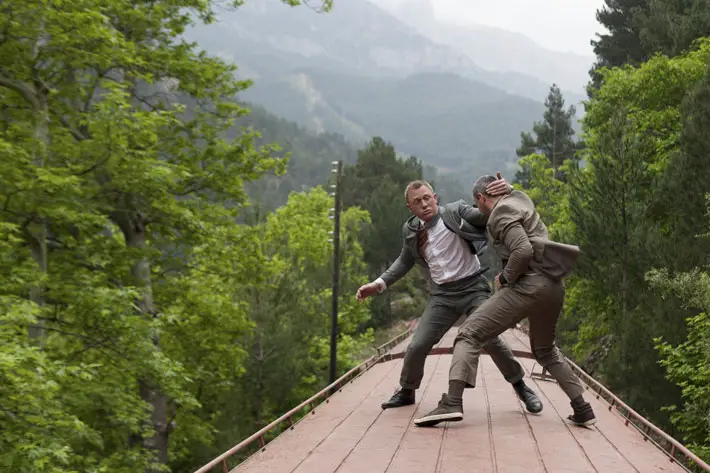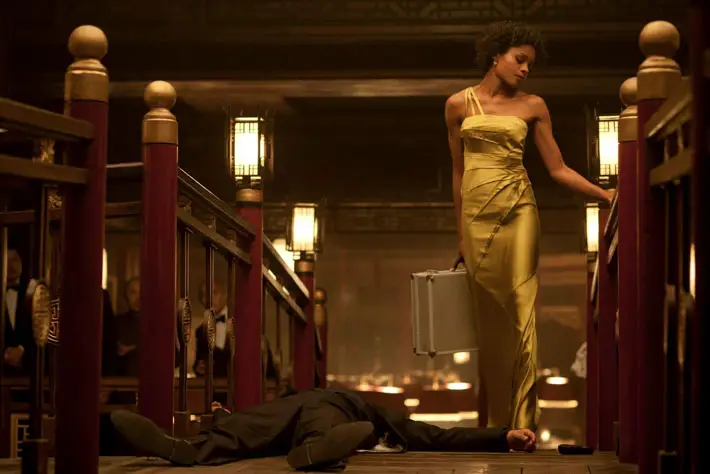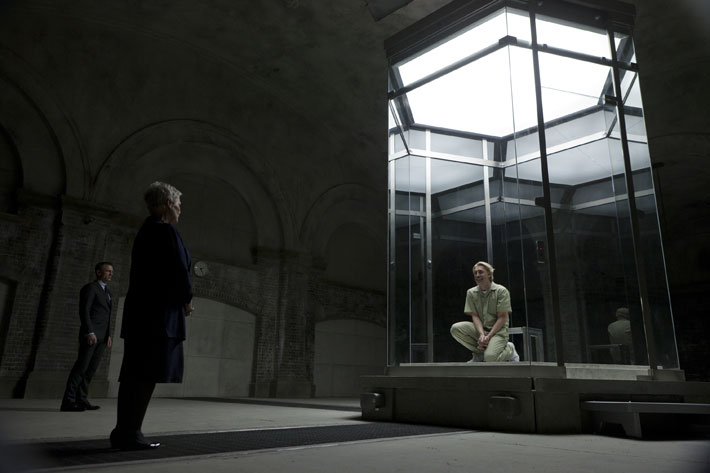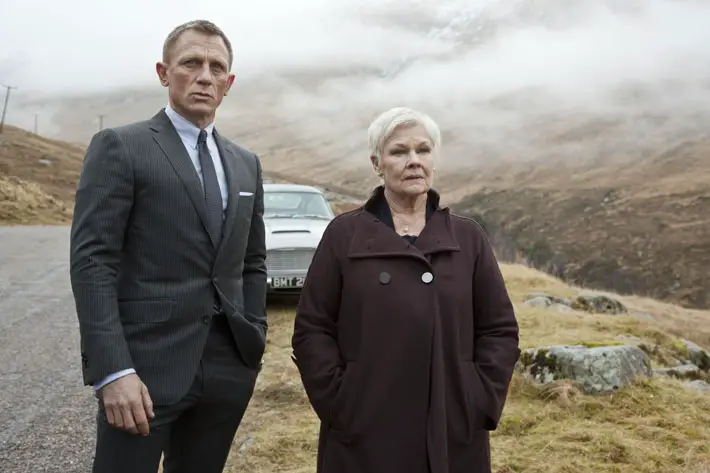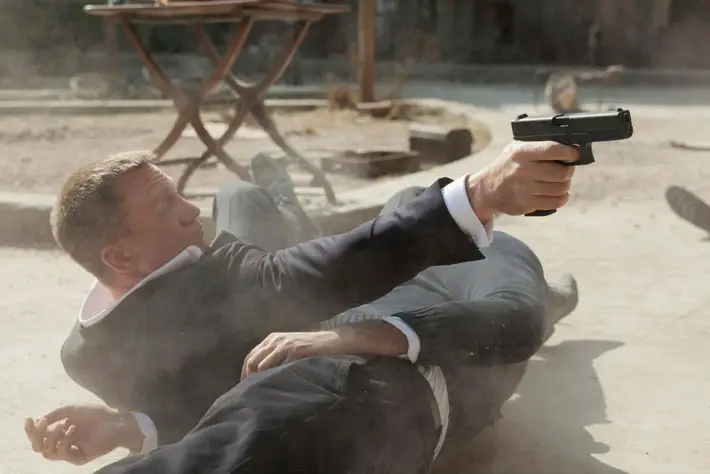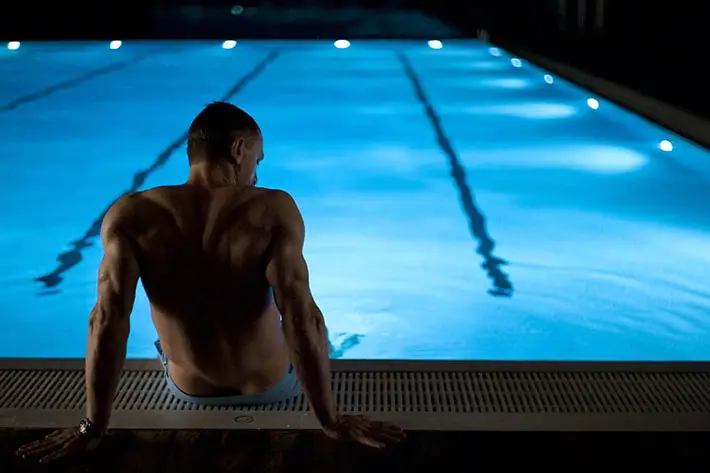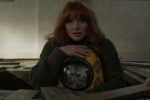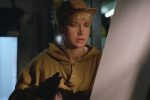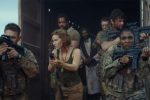Skyfall (2012) – Film Review
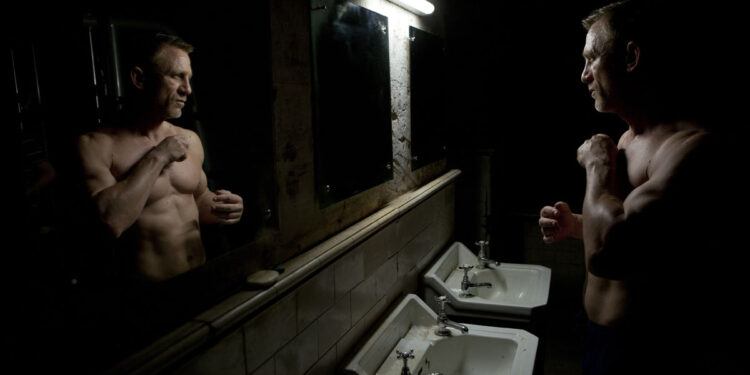
Director: Sam Mendes
Cast: Daniel Craig, Judi Dench, Javier Bardem
Certificate: 12A
By @Roger Crow
James Bond’s 50th anniversary movie had to be something special. The fact it was released in the year of the London Olympics meant we also saw Daniel Craig’s Bond co-star with the actual Queen in one of those jaw-dropping short films which made the event so special.
And the feature itself did not disappoint either. Far from it.
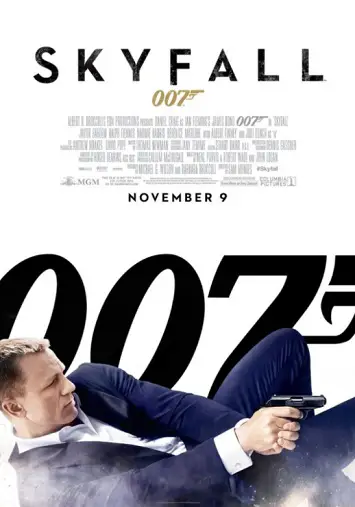 Not that I’m Craig’s biggest fan; he’s a great actor, as he’s proved many times in films you may never have seen, such as The Jacket, but as Bond? Not quite my cuppa. However, Skyfall, for me at least, was the film where everything gelled.
Not that I’m Craig’s biggest fan; he’s a great actor, as he’s proved many times in films you may never have seen, such as The Jacket, but as Bond? Not quite my cuppa. However, Skyfall, for me at least, was the film where everything gelled.
“Head shot”
We open, unconventionally, without the gun barrel. Just a Turkish corridor, and a shadowy figure who comes into focus. Our man is on a mission, as usual, and there’s an agent down, bleeding to death, while a crucial bit of tech is missing.
Like the best Bond movies, what follows is a fluid series of events, all interconnected. There’s a real sense of momentum as Bond leaves the building, and his ride arrives. What started on foot, now becomes a chase on four wheels as 007 and his glamorous ally Eve (Naomie Harris) chase after the villain in a Land Rover. Ola Rapace (former husband of Noomi) is Patrice, the bad guy who fires a weapon that couldn’t look more like male genitalia if it tried.
Then we’re off again, and Bond is on a motorbike, chasing across rooftops and breaking things like an Istanbul in a China shop.
Eventually James arrives on a train, still chasing the bad guy while Eve drives alongside, dictating the action to M in London.
Following some staggering product placement for a car brand, Bond trashes the cargo with heavy machinery; climbs aboard the collapsing train, and winds up fighting the villain on top of the vehicle while Eve takes aim from a distance.
“Take the bloody shot!” demands M. But instead of aiming for ankles, she goes for a head shot, and naturally hits Bond, while the bad guy gets away.
“Beautifully crafted”
As pre-credits go, it’s up there with the best of them. Then we have THAT theme.
Adele was such a natural fit, I wasn’t the only one who hoped she would get the gig a year before the movie was released. And what a theme. Haunting, enigmatic and absolutely right for the movie. Little wonder it won an Oscar.
The fact the stunning opening titles hint at everything that follows matters little. They’re beautifully crafted by Daniel Kleinman.
Bond obviously survived the shot, and is now washed up in more ways than one. When he’s not bedding a beautiful woman, he’s moping around on a beach and sharing drinks with a scorpion in a game worthy of Marion’s bar in Raiders of the Lost Ark.
However, when MI6’s HQ is blown up (a terrific action scene, not least because of M’s annoyance at being stopped by police), 007 returns to London, and in particular M’s house (actually John Barry’s old residence).
Poor M is forced to retire thanks to Bond losing the gizmo which exposes MI6 agents. Shadowy fellow employee Mallory (Ralph Fiennes) is the axe man, and he’s clearly out for blood.
“A nerve has been touched”
M’s arc in Skyfall is one of its greatest strengths, and also gives dear Dame Judi Dench some of her best scenes of the franchise.
Craig’s Bond seems to be on his last legs a mere three films into his tenure, which is strange, but the fact he fails his tests makes him more human than the super spy we have come to expect.
In one of the finest scenes, Bond is analysed and asked what ‘Skyfall’ means to him. The fed up mood changes, and it’s clear a nerve has been touched. A riddle, wrapped in an enigma, the way all good spy thrillers should be.
Enter Q, and a scene which ranks as a favourite in the entire saga. Ben Whishaw’s IT Crowd-worthy gadget man is a terrific take on an old legend. The scene with him and Bond staring at Turner’s ‘The Fighting Temeraire’ at the National Gallery is a masterclass in understatement.
007 does a little detective work, and after a stunning fight in a high rise (Roger Deakins’ cinematography is an all-time high for the saga), Bond gets just enough info (via a casino chip) to send him to Macau.
It’s testament to the art directors that Craig didn’t go to China to film his scenes, but a few well placed props and clever locations in London ensure the illusion is perfectly credible.
“New energy”
After seducing Patrice’s associates, the stunning Severine (Berenice Marlohe) in a casino (one of THE best scenes between Bond and a sacrificial pawn in any 007 movie), he fights off bad guys and winds up en route to big bad Silva’s base.
The moral complexity of James seducing such a broken woman (a former sex slave) makes you realise 007 has no scruples when it comes to getting what he wants. What was once Bond just bedding beautiful women as part of the usual checklist of 007 movie tropes enters far darker territory in Skyfall. The fact Ms Marlohe gives such a phenomenal performance as the sacrificial pawn should not be overlooked.
By this point there hasn’t been a single bad moment in the movie, which is rare for any film. Everything is on point, and when Silva turns up an hour into the movie, a new energy arrives. Yes, Sam Mendes owes a lot to Chris Nolan’s The Dark Knight in places, but this is still magnetic stuff, especially Silva’s one-take arrival speech about rats and a barrel.
Javier Bardem was of course phenomenal in No Country For Old Men, and was no doubt asked to do that “menacing thing” again. He does not disappoint, especially when he gets a little too close to Bond for comfort. This was the first time on film at least 007’s sexuality was questioned, which adds another layer to the drama.
“Hell breaks loose”
With Severine sadly dispatched, Silva is captured and taken to London, where M reflects on the consequences of her past. The ’bad pupil’ who went unchecked has now returned to ’the head mistress’ office’, and it’s clear he has a plan.
Once Silva inevitably escapes via some clever computer-based jiggery pokery, then almost drops a Tube train on Bond’s head, M goes to a hearing with fearsome Clair Dowar MP (the much missed Helen McCrory). Dowar attempts to destroy M like an evil barrister terrorising a pensioner.
Tanner (utterly useless, despite a great turn from Rory Kinnear) is told to get M to safety, but he hesitates; Silva bursts in with his army of goons and all hell breaks loose. Another fantastic set piece, with Bond, Mallory and Eve sharing the action.
As Bond whisks M to safety, he takes her to his garage where his faithful Aston Martin is waiting.
From that point on, and their drive to Scotland, the master stroke is Bond and M relying mostly on tech from 50 years earlier. No gadgets, or hi-tech stuff to get them out of scrapes. Just 1960s-era ingenuity, while Silva and his bad guys ignore all that nostalgia stuff and use a helicopter gunship.
“Stripped down action”
The moment Bond stretches his legs in Scotland and M fills in some backstory about his early days is superb. Visually stunning, beautifully written and acted. It’s the calm before the storm of what follows, and like the earlier National Gallery scene, it’s those quiet moments which really make Skyfall work.
The finale at Bond’s eponymous childhood home may be dismissed by some as “Home Alone for adults”, but it’s far better than that.
For the DVD launch in 2013, I interviewed writers Neal Purvis and Robert Wade on a train that recreated Bond’s trek from London to Scotland. I told them my theory about why the finale works, which they hadn’t considered.
’Viewers can’t relate to someone trying to take over the world, but they can relate to someone breaking into their house.’ Analyse that, Sigmund Freud.
As Bond, M and old gamekeeper Kincade (the ever wondrous and much missed Albert Finney) fortify the Skyfall residence with home-made traps, what follows is stripped down action at its best. Straw Dogs did it years earlier, but a domestic siege in a 007 movie is very rare.
The bulk of James’s adventures might be a playboy’s view of the world, but Skyfall gives us a Bond who puts away his toys and grows up. The greatest challenge is not arch villains, but dealing with ageing, and loss.
“Nagging question”
By 2012, many who grew up with 007 in the sixties and seventies; taken to the cinema by their parents and guardians, were coping with the inevitability of becoming orphans themselves, like their hero.
Little wonder Skyfall touches a chord with viewers of a certain age. The simple act of a middle-aged son trying to protect his surrogate pensioner parents from enemy forces. No, not unscrupulous window-fitters who do half a job, or dodgy salesmen, but Blighty’s greatest action hero, or ‘White Knight’ defending his ‘Queen’ from that final check mate.
Though the final few minutes are admittedly annoying, as a wounded M and Kincade flee through the Scottish darkness, but stupidly use a torch to pinpoint their location to Silva, M’s demise in a church is Bond at its best. And yes, up there with the finale of On Her Majesty’s Secret Service.
By the epilogue, all becomes clear. Eve is the new Moneypenny, Mallory is the new M, and the MI6 office of old is also back. (How I missed that padded door).
The odd nagging question remains, such as: did Bond bed Moneypenny after a close shave? We may never know.
“Classic”
I do know Skyfall is a terrific adventure; an often beautifully acted and scripted classic, with stunning cinematography and excellent set pieces.
Bond purists might not like it, but each to their own. As the first 007 movie to make more than a billion dollars at the box office, it didn’t just appeal to many fans, but reminded lapsed followers how good Bond could be, especially when tackling themes relevant to everyone of a certain age.
Skyfall is where we start the Sam Mendes 007s, and Spectre is where we end.
